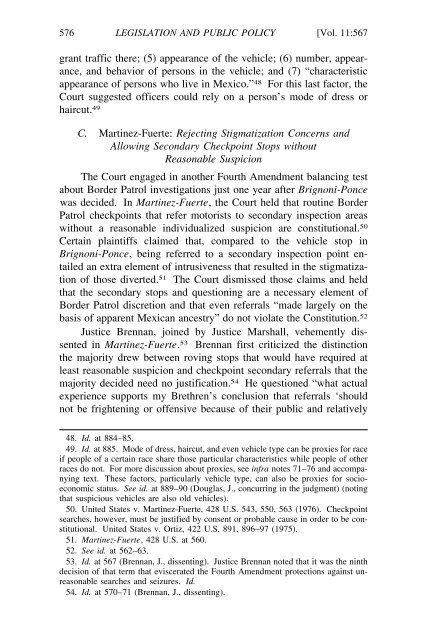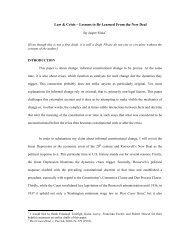updating brignoni-ponce - New York University School of Law
updating brignoni-ponce - New York University School of Law
updating brignoni-ponce - New York University School of Law
Create successful ePaper yourself
Turn your PDF publications into a flip-book with our unique Google optimized e-Paper software.
576 LEGISLATION AND PUBLIC POLICY [Vol. 11:567<br />
grant traffic there; (5) appearance <strong>of</strong> the vehicle; (6) number, appearance,<br />
and behavior <strong>of</strong> persons in the vehicle; and (7) “characteristic<br />
appearance <strong>of</strong> persons who live in Mexico.” 48 For this last factor, the<br />
Court suggested <strong>of</strong>ficers could rely on a person’s mode <strong>of</strong> dress or<br />
haircut. 49<br />
C. Martinez-Fuerte: Rejecting Stigmatization Concerns and<br />
Allowing Secondary Checkpoint Stops without<br />
Reasonable Suspicion<br />
The Court engaged in another Fourth Amendment balancing test<br />
about Border Patrol investigations just one year after Brignoni-Ponce<br />
was decided. In Martinez-Fuerte, the Court held that routine Border<br />
Patrol checkpoints that refer motorists to secondary inspection areas<br />
without a reasonable individualized suspicion are constitutional. 50<br />
Certain plaintiffs claimed that, compared to the vehicle stop in<br />
Brignoni-Ponce, being referred to a secondary inspection point entailed<br />
an extra element <strong>of</strong> intrusiveness that resulted in the stigmatization<br />
<strong>of</strong> those diverted. 51 The Court dismissed those claims and held<br />
that the secondary stops and questioning are a necessary element <strong>of</strong><br />
Border Patrol discretion and that even referrals “made largely on the<br />
basis <strong>of</strong> apparent Mexican ancestry” do not violate the Constitution. 52<br />
Justice Brennan, joined by Justice Marshall, vehemently dissented<br />
in Martinez-Fuerte. 53 Brennan first criticized the distinction<br />
the majority drew between roving stops that would have required at<br />
least reasonable suspicion and checkpoint secondary referrals that the<br />
majority decided need no justification. 54 He questioned “what actual<br />
experience supports my Brethren’s conclusion that referrals ‘should<br />
not be frightening or <strong>of</strong>fensive because <strong>of</strong> their public and relatively<br />
48. Id. at 884–85.<br />
49. Id. at 885. Mode <strong>of</strong> dress, haircut, and even vehicle type can be proxies for race<br />
if people <strong>of</strong> a certain race share those particular characteristics while people <strong>of</strong> other<br />
races do not. For more discussion about proxies, see infra notes 71–76 and accompa- R<br />
nying text. These factors, particularly vehicle type, can also be proxies for socioeconomic<br />
status. See id. at 889–90 (Douglas, J., concurring in the judgment) (noting<br />
that suspicious vehicles are also old vehicles).<br />
50. United States v. Martinez-Fuerte, 428 U.S. 543, 550, 563 (1976). Checkpoint<br />
searches, however, must be justified by consent or probable cause in order to be constitutional.<br />
United States v. Ortiz, 422 U.S. 891, 896–97 (1975).<br />
51. Martinez-Fuerte, 428 U.S. at 560.<br />
52. See id. at 562–63.<br />
53. Id. at 567 (Brennan, J., dissenting). Justice Brennan noted that it was the ninth<br />
decision <strong>of</strong> that term that eviscerated the Fourth Amendment protections against unreasonable<br />
searches and seizures. Id.<br />
54. Id. at 570–71 (Brennan, J., dissenting).
















